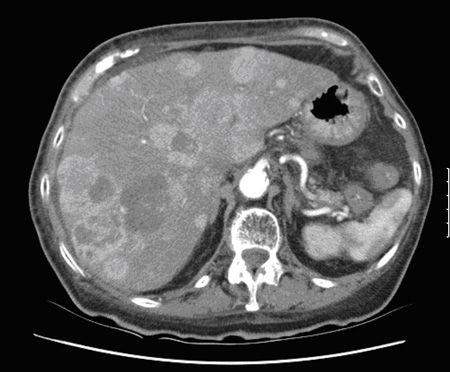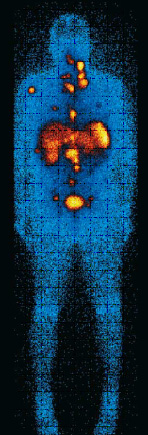Tests
1st tests to order
serum chromogranin A/B
Test
Specialized test, not performed routinely in many laboratories.
Blood samples need to be stored immediately on ice. Sensitivity 60% to 90%. False-positives arise due to impaired renal function, chronic atrophic gastritis, and treatment with proton pump inhibitors.
Useful as a marker for monitoring disease burden and progression.
Result
elevated
urinary 5-hydroxyindoleacetic acid
Test
24-hour collection of urine is required.
48 hours prior to collection and 24 hours during collection, dietary restrictions required for accurate results. Patients should avoid certain food and medications such as avocados, cantaloupe, eggplant, pineapples, plums, tomatoes, hickory nuts/pecans, plantains, kiwi, dates, grapefruit, honeydew, walnuts, bananas, chocolate, caffeine, cough and cold medicines containing expectorants, and muscle relaxants (e.g., methocarbamol).[2]
Urine should be collected in a bottle containing acid so that pH is <3. In midgut carcinoid patients, sensitivity is approximately 60% to 70%, although higher rates have been reported.
Result
elevated
metabolic panel
Test
Used routinely as part of the initial workup. Enzymatic assays are used to measure plasma creatinine levels.
Result
elevated creatinine if dehydrated from diarrhea
liver function tests
Test
Used routinely as part of the initial workup. Levels of alanine aminotransferase(ALT), aspartate aminotransferase (AST), alkaline phosphatase (ALP), and gamma-glutamyl transferase (GGT) are measured. One small study has shown that only 28.6% of patients with carcinoid tumors have abnormal liver test results, and so other investigations such as imaging tests are also needed for diagnosis.[19]
Result
variable, changes include aminotransferase elevation depending on site of tumor
complete blood count
Test
Should be ordered in all patients with suspected carcinoid syndrome as part of the initial evaluation.
Result
usually normal
Tests to consider
CT chest, abdomen, and pelvis with dual-phase liver
Test
Routine staging should be performed every 4 to 6 months.
Used to monitor progression of the disease.[Figure caption and citation for the preceding image starts]: CT scan showing multiple liver metastasesFrom the collection of Dr R. Srirajaskanthan and Dr M. Caplin; used with permission [Citation ends].
Result
identifies location of primary tumor, presence of liver metastases
bronchoscopy
Test
Result
identifies location of primary tumor
endoscopy
Test
Result
identifies location of primary tumor
somatostatin receptor scintigraphy ± somatostatin single photon emission CT (SPECT)
Test
Somatostatin receptor type 2 is present in 70% to 90% of carcinoid tumors. Most commonly used ligand is indium 111-In-diethylenetriaminepentaacetic acid (DTPA)-octreotide.
Available in most nuclear medicine departments. Referral to a specialist center may be required.
SPECT can be used where available. Sensitivity of 80% to 100% is reported when 111-In-DTPA-octreotide SPECT is used.
Result
identifies areas of somatostatin receptor-positive tumor
iodine I-123 metaiodobenzylguanidine (MIBG) scintigraphy
Test
The compound is taken up and concentrated in endocrine cells. MIBG has a sensitivity of 50% in patients with carcinoid syndrome. The test can be requested from a nuclear medicine department but may require specialist referral. [Figure caption and citation for the preceding image starts]: Iodine I-123 metaiodobenzylguanidine (MIBG) uptake image showing multiple metastasesFrom the collection of Dr R. Srirajaskanthan and Dr M. Caplin; used with permission [Citation ends].
Result
identifies areas of tumor through MIBG takeup
histology
Test
Biopsy of either a liver metastasis or primary lesion is helpful in determining the underlying type of tumor and stage of tumor.
Result
identifies tumor type and stage
somatostatin receptor positron emission tomography (SSTR-PET) or fludeoxyglucose F-18 (FDG)
Test
Somatostatin receptor imaging is required for all patients with a histologically proven neuroendocrine tumor (NET) or suspected lesions on cross sectional imaging. The preferred method is SSTR-PET. Commonly used tracers include gallium (Ga)-68 dotatate, gallium Ga-68 dotanoc, and GA-68 dotatoc.
FDG PET is of use in patients with intermediate- and high-grade NETs. There are other tracers in development that are potentially of interest.
Result
identifies areas of somatostatin receptor-positive tumor
Use of this content is subject to our disclaimer